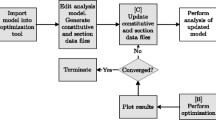Abstract
This paper illustrates the effect of loading conditions and lamination parameters on the optimum design of the laminated composite plates. Optimum design procedure based on the flexibility criterion is presented in this paper. The objective is to determine the optimum thickness of the laminate layers and its optimum orientations without exhibiting any failure. The finite element method based on Mindlin plate theory is used in conjunction with an optimization method in order to determine the optimum design. Newmark implicit time integration scheme is used to discretize the time domain and calculate the transient response of the laminated plate. Exterior penalty method is exploited as a constrained minimization technique. For this purpose, four numerical examples are presented to figure out the effects of dynamic loading profile, boundary conditions, number of layers, and degree of orthotropy on the optimum weight design.
Similar content being viewed by others
References
Y. X. Zhang and C. H. Yang, Recent developments in finite element analysis for laminated composite plates, Composite Structures, 88 (2009) 147–157.
T. Y. Kam and R. R. Chang, Optimal design of laminated composite plates with dynamic and static constraints, Computers & Structures, 32(2) (1989) 387–393.
Y. S. Lee, Y. M. Lee and M. S. Na, Optimal design of hybrid laminated composite plates with dynamic and static constraints, Computers & Structures, 50(6) (1994) 797–803.
M. Walker, T. Reiss and S. Adali, Optimal design of symmetrically laminated plates for minimum deflection and weight, Composite Structures, 39 (1997) 337–346.
P. M. Manne and S. W. Tsai, Design optimization of composite plates: Part I-design criteria for strength, stiffness, and manufacturing complexity of composite materials, Composite Materials, 32(6) (1998) 544–571.
P. M. Manne and S. W. Tsai, Design optimization of composite plates: Part II-structural optimization by plydrop targeting, Composite Materials, 32(6) (1998) 572–598.
A. S. Fine and G. S. Springer, Design of composite laminates for strength, weight, and manufacturability, Composite Materials, 31(23) (1997) 2330–2390.
B. Liu, R. T. Haftka, M. A. Akgun and A. Todoroki, Permutation genetic algorithm for stacking sequence design of composite laminates, Comput. Meth. Appl. Mech. Engng., 186 (2000) 357–372.
A. Todoroki and R. T. Haftka, Stacking sequence optimization by a genetic algorithm with a new recessive gene like repair strategy, Composites Part B, 29B (1998) 277–285.
E. Potgieter and N. Stander, The genetic algorithm applied to stiffness maximization of laminated plates, Struct. Optimiz., 15 (1998) 221–229.
R. L. Riche and R. T. Haftka, Improved genetic algorithm for minimum thickness composite laminate design, Compos. Eng., 5(2) (1995) 143–161.
F. S Almeida and A. M. Awruch, Design optimization of composite laminated structures using genetic algorithms and finite element analysis, Composite Structures, 88 (2009) 443–454.
C. H. Park, W. I. Lee, W. S. Han and A. Vautrin, Weight minimization of composite laminated plates with multiple constraints, Composite Science and Technology, 63 (2003) 1015–1026.
B. Farshi and S. Herasati, Optimum weight design of fiber composite plates in flexure based on a two level strategy, Composite Structures, 73 (2006) 495–504.
C. H. Park, A. Saouab, J. Bréard, W. S. Han, A. Vautrin, W. I. Lee, An integrated optimisation for the weight, the structural performance and the cost of composite structures, Composites Science and Technology, 69 (2009) 1101–1107.
B. Niu, N. Olhoff, E. Lund and G. Cheng, Discrete material optimization of vibrating laminated composite plates for minimum sound radiation, International Journal of Solids and Structures, 47 (2010) 2097–2114.
J. N. Reddy, Mechanics of laminated composite plates, CRC, New York (1997).
K. Deb, Optimization for engineering design algorithms and examples, Prentice-Hall, New Delhi (1995).
J. S. Arora, Introduction to optimum design, McGraw-Hill, New York (1989).
R. M. Jones, Mechanics of composite materials, Second edition, Taylor & Francis (1999).
Author information
Authors and Affiliations
Corresponding author
Additional information
This paper was recommended for publication in revised form by Editor Yeon June Kang
A. M. Kabeel received his B.S, and M.S. in Mechanical Engineering from Zagazig University, Egypt in 1999 and 2007, respectively. A.M. Kabeel is currently an assistance lecturer of the Department of Mechanical Design and Production Engineering of Zagazig University, Egypt. His research fields are dynamic analysis, optimization, composite structural, finite element analysis and continuum mechanics.
Rights and permissions
About this article
Cite this article
Assie, A.E., Kabeel, A.M. & Mahmoud, F.F. Effect of loading and lamination parameters on the optimum design of laminated plates. J Mech Sci Technol 25, 1149–1158 (2011). https://doi.org/10.1007/s12206-011-0336-9
Received:
Revised:
Accepted:
Published:
Issue Date:
DOI: https://doi.org/10.1007/s12206-011-0336-9




